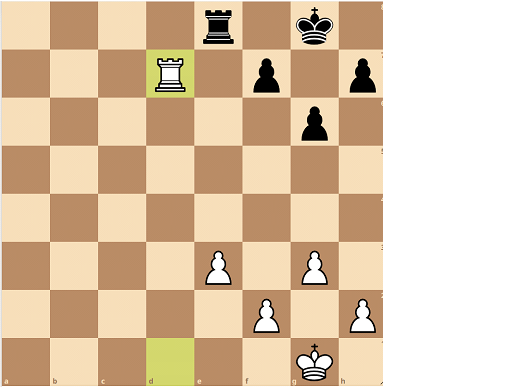Play chess for any length of time and eventually you will be asked to defend this position:

Black to play.
We've all either been told or just feel this should be defendable for black, despite black being a pawn down. 'All rook endings are drawn' is a humorous generalisation, but it's also a mantra you can use to reassure yourself when under pressure. As always, activity is the key. You must activate your rook.
36... Rb8!

The rook threatens to go to b2 should white move the f2 pawn. Should white move the f2 pawn, his king becomes trapped on the back rank. If the f2 pawn cannot move, white cannot move their pawn majority. If they can't push their 4 pawns in formation, then they can't make use of their extra pawn.
If white plays 37. g4 Rb5! (a useful move, as we'll see) 38. h4 (white gets the other pawn moving, and hopes to get his king to g3 before safely moving the f2 pawn.) h5!

Black nails down the h4 pawn as a weakness. h4 becomes the base of a very small chain (h4-g5). The base of the chain is where, even as a defender, you should attack.
39.g5 Rb2 40. Kg2 Rb1 41. Kg3 Rb1 42. Rd4 Rh1

White is tied down to h4. When the f2 pawn moves - and it must, if white is trying to win - the rook can harass the king.
43.Ra4 Kf8 44. Ra2 Re1 45. Ra3 Kg7 46. Ra5 Kf8 47. Re5 Kg7 48. f4 Rg1+ 0.5-0.5

Should the king go h2, the rook goes to g4 to attack h4. Should the king go to h3, the rook goes to h1. Draw.
Ok, that's the easy part. But life isn't easy. What if white already has his f-pawn on the March, and white's pawn majority is rolling up the board? What if, in addition, white's king gets in front of the g-pawn and joins in?
What follows is one of the greatest, if not the greatest player of all time, Gary Kasparov, managing to lose such a position, even though it's a book draw. Before we see how it should be played by black, it's worth seeing how white can generate winning chances against inferior play.
The game is Piket, Jeroen - Kasparov, Gary Kasparov Grand Prix (internet), 2000

Here Kasparov played 44... Re1? and Piket replied 45. Rc7! (arranging a potential sacrificial breakthrough.) Re2 46. Re7 Ra2 47. f5!

47...gxf5 48. e6! (Breakthrough) h4 49. Rxf7+ Kg8 50. Kf6 1-0
If it can happen to the best, it can happen to the rest. Remember: Under pressure, we all lose basic endings from time to time, regardless as to whether we know how to play them! So don't beat yourself up when it happens (wait until it becomes a habit for that).
This was only a rapid game, and Kasparov was in severe time trouble, but then the likelihood will be that you will be too. Here's how he could have saved it. From the original position, the third rank is key:

44... Ra3! (The third rank is key. Why? Firstly, immediately, because it prevents the h-pawn advancing, as g3 falls. But also...) 45. Rc7 Ra5!

Pinning the e5 pawn. If you cannot attack the base of the pawn chain, attack the head.
It's still difficult to see how black can draw this. But after 46. Re7 Ra4 47. e6 Ra5+ 48.Kh4 black has the cold ... Kf6!

49.Rxf7+ Kxe6 (and white is going nowhere.)
Now that looked a little tricky. But against best play from your opponent almost everything is going to be taxing. That's chess. A game isn't over until it's over.
